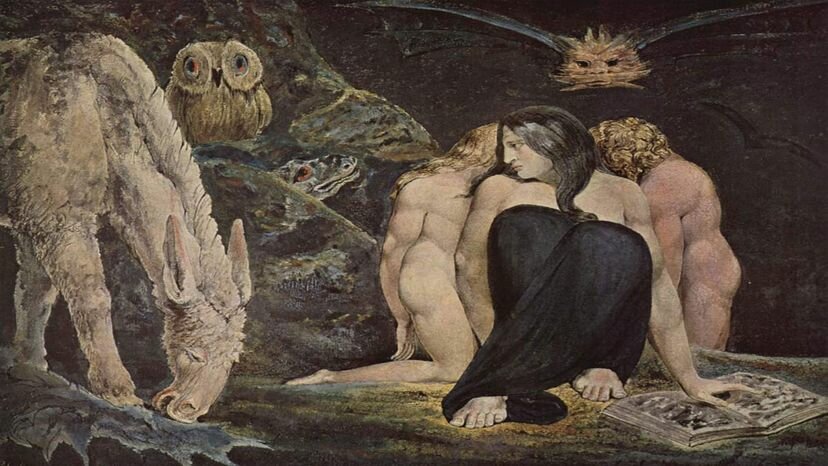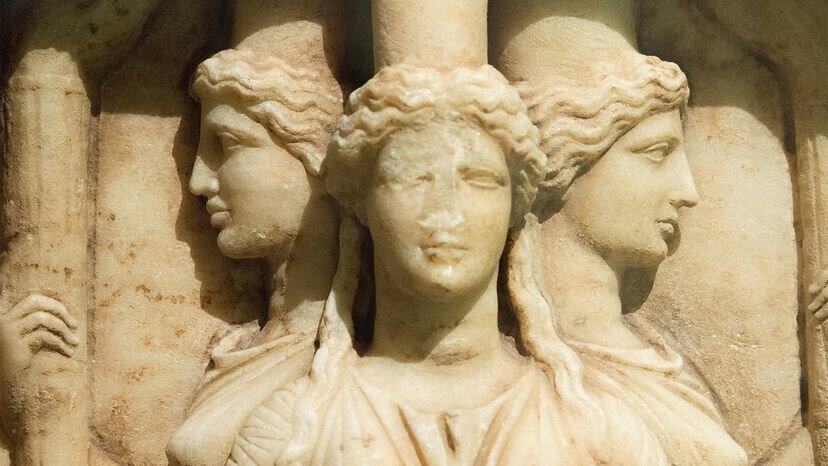
Triple-faced and triple-bodied, Hekate (also sometimes spelled “Hecate”) is a goddess of crossroads who presents a different form to each direction. This is a fitting depiction, as Hekate also seems to present a different visage to the varying times and cultures that consider her.
This statement is true of most gods and goddesses. Divine beings, after all, have no objective reality. They reside within human imagination, tradition and literature. Their roles, stories and manifestations change over time and whatever stability they have stems from anchoring orthodoxies, texts and visual works.
For many gods and goddesses in the Greek tradition, Hesiod’s eighth-century B.C.E. poem “Theogony” is just such a work. The Greek poet drew on varying traditions to present a synthesized genealogy for everyone from Aglaea to Zeus. Not only does Hesiod mention Hekate in her earliest surviving literary appearance, the poet also devotes a seemingly disproportionate amount of space to her praise.
As pointed out by Jenny Strauss Clay in “The Hecate of the Theogony,” Hesiod’s “Hymn to Hekate” has even stood out to some historians as a possible insertion as “Hesiod appears to drop everything in order to launch into an extended encomium of Hekate.”
The “Theogony” describes the goddess as an honorable and influential figure in the Greek pantheon. Her power, it relates, predates the rise of Zeus and his Olympians, but Hekate avoids the fate of the titans who opposed the new gods. Zeus, Poseidon and their kin certainly surpass her, but she still retains influences in multiple spheres, including the sea, childbirth and herding.

Triple-faced and triple-bodied, Hekate (also sometimes spelled “Hecate”) is a goddess of crossroads who presents a different form to each direction. This is a fitting depiction, as Hekate also seems to present a different visage to the varying times and cultures that consider her.
This statement is true of most gods and goddesses. Divine beings, after all, have no objective reality. They reside within human imagination, tradition and literature. Their roles, stories and manifestations change over time and whatever stability they have stems from anchoring orthodoxies, texts and visual works.
For many gods and goddesses in the Greek tradition, Hesiod’s eighth-century B.C.E. poem “Theogony” is just such a work. The Greek poet drew on varying traditions to present a synthesized genealogy for everyone from Aglaea to Zeus. Not only does Hesiod mention Hekate in her earliest surviving literary appearance, the poet also devotes a seemingly disproportionate amount of space to her praise.
As pointed out by Jenny Strauss Clay in “The Hecate of the Theogony,” Hesiod’s “Hymn to Hekate” has even stood out to some historians as a possible insertion as “Hesiod appears to drop everything in order to launch into an extended encomium of Hekate.”
The “Theogony” describes the goddess as an honorable and influential figure in the Greek pantheon. Her power, it relates, predates the rise of Zeus and his Olympians, but Hekate avoids the fate of the titans who opposed the new gods. Zeus, Poseidon and their kin certainly surpass her, but she still retains influences in multiple spheres, including the sea, childbirth and herding.
Table of Contents
Hekate Was a Crucial Intermediary
As Clay describes, Hekate stands as a kind of anti-Prometheus in Greek traditions. While the fire-bearing titan worsened relationships between gods and mortals, Hekate takes on the role of a crucial intermediary — a fitting position for a goddess of boundaries and crossroads. While some experts attribute Hesiod’s Hekate fandom to his own personal worship of the deity, or perhaps his home village’s connection to her, Clay interprets the focus as no mere whim, but rather a testament to Hekate’s “critical mediating function” in the pantheon.
As Patricia A. Marquardt pointed out in “A Portrait of Hecate,” Hesiod describes Hekate not as a distant entity but rather a direct force in mortal life. She is a personal or household deity, and likely represents an independent religious tradition folded into the Olympian pantheon. Her origins are shrouded in mystery — also quite befitting of a goddess later associated with night and witchcraft — but she likely emerges from the Caria region of Western Anatolia, though Egyptian and Greek origins have also been proposed.
The Cult of Hekate
The oldest actual physical evidence of a cult of Hekate, found in inscriptions at a temple of Apollo Delphinios in Miletus, actually dates to the sixth century B.C.E., some two centuries after Hesiod. Her oldest surviving depiction also dates to the same time period: a terracotta statue of the goddess seated on a throne. Her triple-bodied likeness, known as the Hekate-Epipyrgidia, appears later in the form of a statue that stood at the entrance to the Athenian Acropolis during the fifth century B.C.E.

As Patricia Monaghan points out in “The Encyclopedia of Goddesses and Heroines,” Hekate has long been depicted holding a blazing torch against the night and accompanied by dogs. In some depictions, one of her three heads is even a dog’s head, alongside a serpent and a horse. The dog was sometimes an animal of sacrifice to Hekate for the Greeks, but the leftovers from sacred suppers in her name were also left out for her hounds (as well as whatever mundane dogs might prowl the streets).
Hekate’s original, pre-Hellenistic form is lost to history, and Hesiod’s treatment of the deity — though glowing — folds her into the Greek pantheon with everyone else. Still other Greek , including Sophocles and Euripides, connect Hekate to witchcraft and death. By the medieval period, European traditions would more expressly transform Hekate into a goddess of witchcraft and the moon. Later still, William Shakespeare invoked this image of the deity in his 17th-century play “Macbeth,” writing “witchcraft celebrates Pale Hekate’s offerings.” The bard also mentions Hekate in “A Midsummer Night’s Dream” and “King Lear.”
Even in recent centuries, Hekate has continued to show differing and varied faces to the world. New religious movements such as various neopagan and Wiccan belief systems breathed new life into her divine persona. In many of these modern traditions, Hekate’s associations with night and death once more take a back seat to her broader powers of influence, and her role as the goddess of boundaries, borders and transitions.
Over the course of millennia, she changes and yet endures.
Now That’s Interesting
Hekate is also the namesake for the large main-belt asteroid 100 Hekate, discovered by astronomer J.C. Watson July 11, 1868. The asteroid has an estimated diameter of about 53 miles (86 kilometers). This is perhaps fitting, given that the asteroid belt is often seen as a sort of boundary between our solar system’s inner, rocky planets and the outer gas giants.




